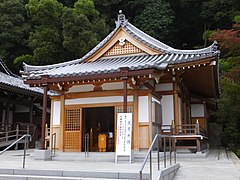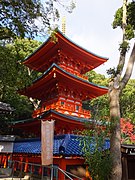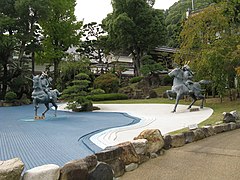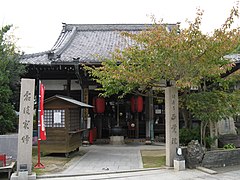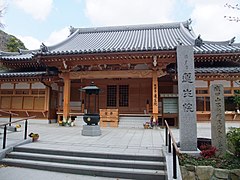Suma-dera
The Suma-dera ( Japanese 須 磨 寺 ) is a Buddhist temple of the Suwa direction of the Shingon in the city of Kobe in Hyogo Prefecture , Japan.
history
The temple was built in 886 at the request of the emperor Kōkō by priest Monkyō ( 聞 鏡 上人 ). In 1946 the temple declared itself as an independent branch of the Shingon.
investment
You enter the temple through the Niō gate ( 仁王 門 Niō -mon ). It is said to have been restored by Minamoto no Yorimasa in the 12th century . The two protective knight figures ( 金剛 力士 Kongō rikishi ) in the side wings are said to have been carved by Unkei and Kaikei . In the main hall ( 本 堂 Hondō ) a seated Kannon is venerated , originally from the Hoppō-ji ( 北 峯 寺 ) of the Egeyama ( 会 下山 ). It is registered as an Important Cultural Asset of Japan .
Originally it was a large temple complex, but at the end of the Edo period only the Niō Gate, the main hall and the Taishi Hall ( 大師 堂 Taishi-dō ) had existed. From the Meiji period onwards, the main hall, the Taishi hall, the Niō gate, the Goma hall ( 護 摩 堂 Goma-dō ) and the three-story pagoda ( 三重 塔 , Sanjū-no-tō) were restored . In the Taishi Hall next to the main hall, a picture of the Kōbō Taishi is venerated under the name “Dear Mr. Taishi of Suma” ( 須 磨 の お 大師 さ ん ).
The sub-temples include the Shōkaku-in ( 正 覚 院 ), the Ōjū-in ( 桜 寿 院 ) and the Renshō-in ( 蓮 生 院 ).
The "Garden of Gempei" ( 源 平 の 庭 ) belongs to the temple , as it is connected to the Minamoto ( Gen ) and the Taira ( Hei ). In the garden are the bell of the Benkei , the pine on which Minamoto no Yoshitsune leaned, the pond in which the head of the Taira no Atsumori was washed. Many poets visited this garden, including Matsuo Bashō , Yosa Buson , Masaoka Shiki .
Treasures
The temple treasures include a base for a Buddha figure ( 宮殿 Kyūden ) and an altar ( 仏 壇 Butsudan ) from 1368, both of which are registered as important cultural assets. Other important cultural assets are an eleven-faced Kannon ( 十 一面 観 音 立 像 ) from the Kamakura period , a painting of the fugues with ten accompanying women ( 普賢 十 羅刹 女 図 Fugen jū rasetsu-zu ) from the Muromachi period . The temple also has pictures and objects that are classified as an important cultural asset of the prefecture.
photos
Remarks
literature
- Hyōgo-ken no rekishi sampo henshu iinkai (ed.): Suma-dera . In: Hyogo-ken no rekishi sampo (jo) . Yamakawa Shuppan, 2012, ISBN 978-4-634-24628-7 .
Web links
Coordinates: 34 ° 38 ′ 59 " N , 135 ° 6 ′ 42.5" E


